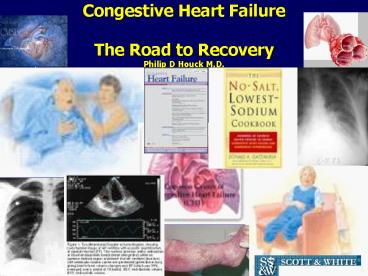Congestive Heart Failure The Road to Recovery Philip D Houck M.D. - PowerPoint PPT Presentation
1 / 37
Title:
Congestive Heart Failure The Road to Recovery Philip D Houck M.D.
Description:
Congestive Heart Failure The Road to Recovery Philip D Houck M.D. * Two primary mechanisms follow from the hypothesis that correction of electrical = correction of ... – PowerPoint PPT presentation
Number of Views:309
Avg rating:3.0/5.0
Title: Congestive Heart Failure The Road to Recovery Philip D Houck M.D.
1
Congestive Heart FailureThe Road to
RecoveryPhilip D Houck M.D.
2
This slide means this is a big expensive problem
3
50 dead in 5 years as bad as Cancer
Dont panic our new therapies are making recovery
and a good life common
4
- Common Causes of Heart Failure
- Hypertension
- Diabetes
- Cholesterol trouble
- Valvular heart disease - leaky or stenotic valves
- Coronary or peripheral vascular disease
- History or symptoms of sleep-disordered breathing
Too fat to breathe while asleep - Heart attacks
- Idiopathic (too dumb to know why)
- Many others
5
- Exposure to cardiotoxic agents
- Current and past alcohol consumption
- Smoking
- Collagen vascular disease
- Exposure to sexually transmitted diseases
- Thyroid disorder
- Pheochromocytoma
- Obesity
6
Diversion to coronary disease Heart attacks
cause Heart Failure
7
What is missing?
8
Ackerman 77 trauma with CAD25 years of age
9
Heart attack in the making
10
Pizza Lecture
11
How can we helpA Broken Heart ?
- Nutrition Salt is your enemy
- Exercise 1 hour per day
- Stop Smoking
- Medications including Statins
- Devices
- Fancy procedures
12
How does heart muscle work?
- Preload
- Afterload
- Contractility Squeeze
- Compliance Filling
- Neuroendocrine
- Geometry Synchronization
- Properties of Blood Vessels
13
How does heart muscle work?
- Preload Water pill
- Afterload Blood pressure pill
- Contractility Digoxin
- Compliance Spironolactone
- Neuroendocrine Beta Blocker ACEI
- Geometry Synchronization
- Properties of Blood Vessels
Medications
Pacemakers
Exercise
14
Neuroendocrine
15
Moderators of Cell death
- Lipophilic Beta Blockers
- Ace Inhibitors
- Ace Blockers AT1
- Spironolactone
- Statins
- Lack of Stem cells
16
Geometry
17
Cardiac Resynchronization Therapy
- Cardiac resynchronization, in association with an
optimized AV delay, improves hemodynamic
performance by forcing the left ventricle to
complete contraction and begin relaxation
earlier, allowing an increase in ventricular
filling time. - Coordinate activation of the ventricles and
septum.
ECG depicting IVCD
18
Ventricular Dysynchrony
19
Proposed Mechanisms of Cardiac Resynchronization
- Improved Contraction Pattern
- AV Interval Optimization
Click to Start/Stop
20
Proposed Mechanisms of Cardiac Resynchronization
- AV Interval Optimization
- Reduces mitral regurgitation1,2,3
- Increases diastolic filling time
- Improves LV dP/dt
Click to Start/Stop
1 Nishimura et al. J Am Coll Cardiol. 1995
25281. 2 Walker et al. Europace 2000I(suppl D)
abstract 212/5. 3 Brecker et al. Lancet.
19923401308.
21
Electro-Myocardial Coupling
- The variables that determine QRS duration are
ventricular size and depolarization propagation
velocity. - Propagation velocity has two components a
circumferential (perpendicular) and axial
(parallel). - The axial velocity must be faster since it has a
greater distance to travel. The axial velocity
parallel to conduction fibers has been
experimentally shown to be higher than the
circumferential velocity perpendicular to the
conduction fibers. The larger the fiber the
greater the velocity
22
- The Dilated Heart
- Perpendicular Propagation velocity 96 cm/sec
- Axial Propagation velocity 84 cm/sec
- The Normal Heart -
- Perpendicular Propagation velocity 106 cm/sec
- Axial Propagation velocity 125 cm/sec
- Axial velocity is always faster than
perpendicular velocity in normal heart - In dilated myopathy this is not true heart
becomes sphereical
23
- Dilated cardiomyopathy with QRS widening is a
slowing of axial electrical propagation velocity
which causes the heart to remodel. The heart
becomes larger and further increases the
propagation times because the fibers become
smaller from the stretch. - Explain Narrow complex dilated myopathy
24
(No Transcript)
25
(No Transcript)
26
(No Transcript)
27
(No Transcript)
28
Systolic versus Diastolic Heart failure(Squeeze)
(Filling)
- Normal Heart recovered
29
Systolic versus Diastolic Heart failure(Squeeze)
(Filling)
- Systolic dysfunction bad squeeze
30
Systolic versus Diastolic Heart failure(Squeeze)
(Filling)
- Diastolic dysfunction increased pressure to
fill
31
(No Transcript)
32
Determinants of Myocardial Performance
- Preload - The stretch of the myocardium
- How do we decrease Preload?
Gravity Sit up, Stand up, Phlebotomy Venodilat
ors NTG Natrecor Morphine Diurectics
Lasix
33
Determinants of Myocardial Performance
- Afterload - The resistance to flow. The size of
the arterioles.
34
(No Transcript)
35
(No Transcript)
36
(No Transcript)
37
(No Transcript)































